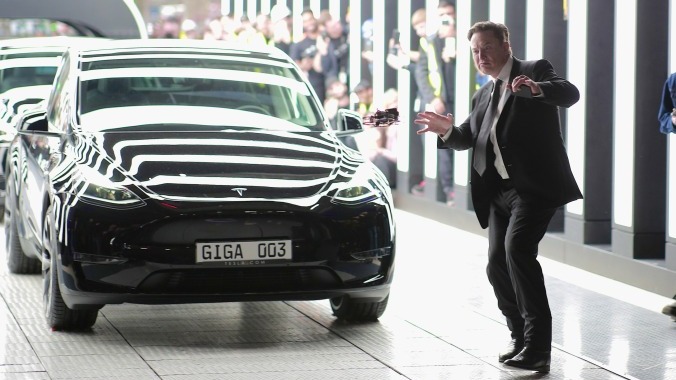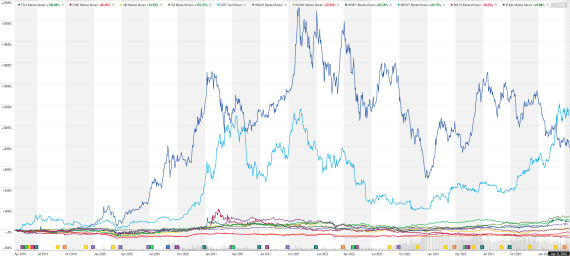Tesla, and therefore Elon Musk, Could Be in Trouble
Photo by Action Press/Shutterstock
Tesla, the only reason any of us are forced against our will to know what an Elon Musk is, slashed over ten percent of its global workforce amidst the departure of two major executives on Monday. This comes with the backdrop of its deliveries falling for the first time since 2020 while demand for Tesla cars has begun to wane as every other car company debuts a fleet of electric vehicles (and as a bonus, you get to have your EV made by an actual car company now too!).
Elon Musk himself has said about Tesla that “The overwhelming focus is solving full self-driving. That’s essential. That’s really the difference between Tesla being worth a lot of money and being worth basically zero.”
Let’s see how that whole self-driving thing is going for Tesla.
Looks like “basically zero” to me.
Tesla has cut Full Self-Driving subscriptions in half, the price of both its Model 3 and Model Y versions in the U.S. and has made similar price cuts in Europe and China after third-quarter deliveries missed expectations last year. This is not as Elon naively asserted, a result of his belief that “most people don’t love to buy cars in the middle of winter.” Something is happening, but given that they just cut prices, it is far too early to come to any firm conclusion about Tesla’s market positioning, other than acknowledging that it is slipping as more and more competitors come on the market.
Unlike my last Elonblog, this article is not rooted in lefty schadenfreude. I’m simply just being a finance school bro here and repeating the news I’ve read in the Wall Street Journal. Musk’s problems are with Rupert Murdoch’s audience, not mine.
After being the market’s golden child for a decade, Tesla may finally be falling back to Earth. And boy howdy does it have a ways to fall.
The following chart from Morningstar tracks stock returns over the last five years for the largest car companies in the world: Tesla (the big dark blue line up top), Ford, GM, Volkswagen, Toyota, Honda, Nissan, Hyundai, Renault, Mercedes, and I also threw Bitcoin on there too for reasons that are obvious (the light blue line underneath the dark blue line).
You don’t need to study finance to know that Tesla’s market return looks more like Bitcoin than it does the actual car companies all clustered near the bottom of the chart.

Tesla acolytes would argue this is the picture of the market paying a premium for innovation, but given that every car company under the sun has their own EV now, what actual innovation has Tesla made other than its supercharger network and being the first mover to grab the government’s money?
Up until very recently, Tesla’s return moved in tandem with Bitcoin. Doesn’t that reveal the true nature of its market value? It’s mainly hype. The math proves its share price is completely divorced from any fundamental valuation of its business.
Tesla stock’s rise to Bitcoin-level mania was fueled by zero interest rates and a bulletproof reputation as America’s lone electric vehicle manufacturer. Elon has now ruined much of that reputation and sticky inflation has all but destroyed the notion of zero percent interest rates forever. We live in a world where tech companies are actually going to have to make money now, not just promise to do so in the distant future.
Tesla’s self-driving feature can generally be described as an aspiring serial killer, and there’s so little demand for it they slashed its price in half. Every car guy you will ever meet can talk your ear off about how everything but the engine is a shoddily built hunk of junk that would never pass inspection on the floor of a real car company. Things are simply not going well for the foundation of Elon’s immense wealth, and he has run out of excuses as the roads fill up with competitors.
“Basically zero” may sound hyperbolic, but it’s actually just a pretty logical conclusion to make once you compare Tesla’s price-to-earnings ratio against real car companies and calculate how far the stock price would need to fall for it to come down into the range of its competitors, all while factoring in Elon’s leverage.
For example, General Motors has a price to earnings ratio of 5.83.
Tesla’s is 37.64.
Meaning that Tesla’s stock price would need to come down eighty-five percent for its P/E ratio to come in range of GM (assuming earnings remain unchanged).
If earnings were meeting or out-performing expectations, the stock price is less of a focus in this ratio, but, well…yeah.
Which brings me to the second half of the title.
Elon Needs Expensive TSLA More than Anyone
Elon has taken loans out against his Tesla shares. He nearly financed his Twitter purchase with them in what would have been a colossal disaster. Tesla’s share price fell after news that he may use it as collateral to overpay for a social network that is famous for not making money, falling far enough that had he financed the deal with Tesla stock, he would have faced a margin call.
A margin call is simple to understand. You post collateral like stock or your house, then borrow money against its value. The entity lending you money requires that you maintain a certain loan-to-value (LTV) ratio. If that ratio rises above the level they set, you are required either to post more collateral, pay down debt, or they can seize your collateral and sell it to pay your debt for you to get your LTV back down. Elon warned everyone against this risky practice last year.
In turbulent economic times, be wary of using margin loans to buy stock
— Elon Musk (@elonmusk) February 2, 2023
Elon has clearly not listened to Elon’s advice. He may not be buying stock (or he may, we don’t know), but he is using margin loans, as the essential Matt Levine detailed for Bloomberg after Musk called off the margin loan to finance his Twitter purchase:
Musk is very rich, but he is not that liquid: Most of his wealth consists of equity stakes in his various companies, not just Tesla but also Boring Co., Space Exploration Technologies Corp., Neuralink and, now, Twitter, or I guess X. Of those companies, only Tesla is publicly traded; he can sell Tesla shares to raise cash, or borrow against them, and he has done both. (He never did the Twitter-related margin loan, but as of this March, out of his roughly 411 million Tesla shares, 238.4 million were “pledged as collateral to secure certain personal indebtedness.”)
As of March last year, a whopping fifty eight percent of Musk’s total Tesla shares are being used as collateral to finance personal loans. At Tesla’s current falling price, that is $37.5 billion worth of collateral. His remaining non-collateralized shares are worth $27.1 billion.
We do not know the details of Elon’s loans, but we know that Tesla executives are allowed to borrow up to twenty-five percent against their TSLA. If Elon has that currently maxed out, he has $9.4 billion in personal debt. Given the immense amount of stock pledged, it’s actually likelier he has a lower LTV ratio (unless he’s just a full-blown psychopath), so let’s give him some credit and say he has a very healthy three percent LTV on all his Tesla stock.
That would still give him $1.1 billion in personal debt as of right now.
Under my hypothetical eighty-five percent TSLA decline to meet GM’s P/E ratio, Elon’s pledged collateral would go from being worth $37.5 billion to $5.6 billion. His neat and tidy three percent LTV would balloon up to twenty percent.
If he’s maxing out his current LTV on his Tesla stock, it would go from twenty-five percent to one-hundred and sixty-eight percent and his phone would melt from the aggression of the incoming margin calls trying to pick his carcass clean.
Remember, this hypothetical LTV is calculated on his total shares pledged, not each individual margin loan of which we do not have the details for. An average LTV limit is around eighty percent. He may be more leveraged than this relatively rosy phone-melting picture paints.
While bringing the P/E ratio down to GM territory without changing earnings is unlikely, Tesla stock still fell sixty-five percent in 2022. A huge crash in its price is not unprecedented nor unreasonable. Hedge fund manager Lekander, who has been shorting Tesla since 2020, thinks my eighty-five percent figure is low and it should fall even more than that, over ninety percent down to $14 a share.
No one—literally no one—needs astronomically high Tesla stock more than Elon Musk. His Twitter purchase and its centrality to it proved this. Everyone who has ever read the Investopedia page for how to do a fundamental analysis agrees that Tesla is worth far too much, so it should fall more than the average in any market pullback, and it has recently. TSLA is the worst performer in the S&P 500 so far this year.
How much it falls is a question that gets to the root of the fundamental valuation of the company, as well as the positioning of large Tesla holders who could have outsized impacts on the markets—like people who say, have billions of dollars in debt collateralized by hilariously over-valued Tesla stock. It especially doesn’t help if those same people have also borrowed $1 billion from SpaceX.
This is where crypto is a good comparison, as one look at the down only bear market charts reveals the impact leverage can have, where forced sellers push prices down further than they otherwise would go. Should Tesla stock travel towards “zero” and turn the car company into a solar panel and supercharger business, Elon Musk looms as planet Earth’s largest forced seller of all time.